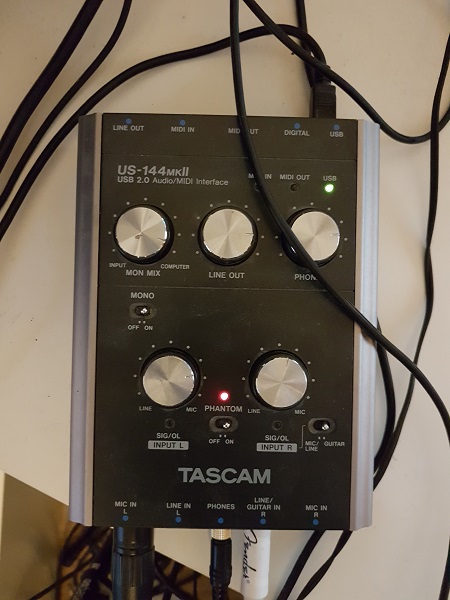Nice guitar! I looked up the specs on the manufacturer's website and they suggest it is in fact a "passive" under saddle pickup which means the pickup does not have "active electronics" or a built in pre-amp and therefore would not require a battery. I don't believe the problem is in your guitar.
The undersaddle pickup in your guitar is most likely a piezo pickup which would be a high impedance pickup which basically means the signal will have a high resistance and need an extra boost in the chain to get enough volume. Without a pre-amp the amplifier or mixer must supply this extra boost or compensate for the higher impedance in the circuitry.
The Tascam interface you pictured does have an input switchable to "guitar" - which is short for - high impedance input from a source such as an electric guitar or bass with passive magnetic pickups or an acoustic guitar with a passive pickup as yours seems to have. This is accomplished on your interface with a switch that can switch the right input from "mic/line" to "guitar".
Theoretically an interface or mixer with a "guitar" level input or "Hi-Z" input should allow you to input the signal from your passive pickup with good results. Checking some on-line reviews of the Tascam you are using suggests that other users have experienced noise and electrical interference issues with that interface similar to what you have described. So the issue may be in the Tascam itself.
The better results you have with your bass might reflect the difference between the way the signal is processed and output from a passive magnetic pickup (typical on most electric guitars and electric bass guitars) which is quite different than from a passive Piezo pickup which your acoustic guitar likely has.
Your guitar connected to the right mixer and amplification system (PA or acoustic amp) may not require a standalone Piezo Pre-amp. But you may benefit tremendously in most applications (particularly recording) by using what is known as a DI Box (which is abbreviation for Direct Injection or Direct Input) also referred to as simply a "Direct Box". I recommend that you try one that is made specifically for acoustic guitars.
Besides acting as a pre-amp for your passive pickup - The most important thing a Direct Box will do is convert the unbalanced signal (subject to the noise you are experiencing) to a balanced signal that will cancel out or otherwise eliminate much of the electronic noise in the signal chain. The output from the DI Box will plug into a balanced XLR input on your interface.
Since your guitar has a passive pickup you will most likely want to use an active Direct Box made specifically for acoustic guitars. See picture below of one example. An active DI (a/k/a Direct Box) will act as a pre-amp for your passive pickup as well as balance the signal from the guitar pickup so that noise is eliminated. Most will also give you other controls such as volume and EQ.
A pre-amp alone would boost the input signal and give you more volume, but would not solve the noise issues resulting from the unbalanced signal (and might even amplify them). What you need is an active direct box which will act as a pre-amp but will also create a balanced signal between pickup and recording interface so that the noise should be abated dramatically if not eliminated altogether.

Pictured above is the LR Baggs Para Acoustic DI Also check out the LR Baggs Venue
The Radial PZ DI box pictured below is advertised as being optimized for piezo input.

Another acoustic DI with good reviews is the Fishman Aura Spectrum DI.
Good luck with your music and enjoy that fine guitar!




mic/line : guitarswitch tomic/line. It's a slightly different signal strength, and sometimes that works better on acoustic pickups. P.S. You can get great sound with an under saddle/piezo pickup; don't believe the hype. I know professionals who use them to record. Practicing is more important.